In the UK, LED lighting prices can range from under £10 for budget options to over £30 for premium products, allowing consumers to choose based on their specific needs and financial considerations. Leading brands such as Philips, Osram, and GE are recognized for their quality and variety, offering solutions that balance energy efficiency with design. Understanding the differences in price points and brand reputation is essential for making informed lighting choices.
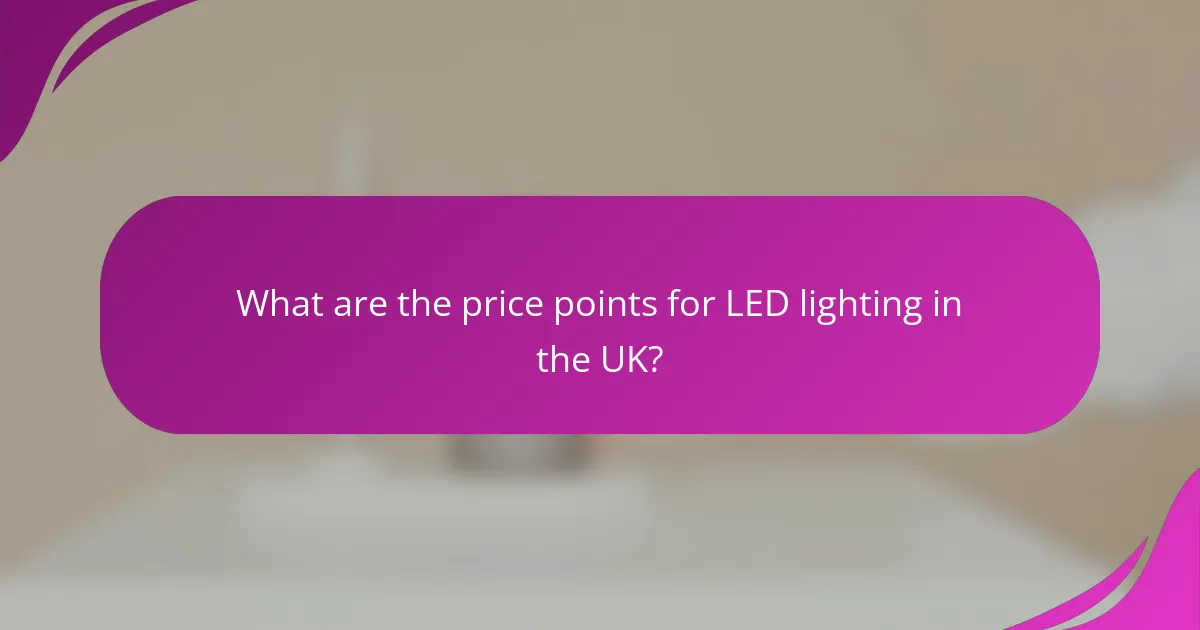
What are the price points for LED lighting in the UK?
In the UK, LED lighting prices vary significantly based on quality and brand, typically ranging from under £10 for budget options to over £30 for premium products. Understanding these price points helps consumers make informed choices based on their lighting needs and budget constraints.
Budget options under £10
Budget LED lights, priced under £10, are ideal for basic lighting needs. These options often include simple bulbs suitable for general use in homes or offices.
Common examples include standard A60 LED bulbs or GU10 spotlights, which can be found in many retail stores and online platforms. While they may lack advanced features, they offer decent energy efficiency and longevity.
Mid-range options £10-£30
Mid-range LED lighting options, priced between £10 and £30, typically provide enhanced features such as adjustable brightness and color temperature. These lights are suitable for more specific applications, like accent lighting or smart home integration.
Brands in this range often include Philips and Osram, which are known for their reliability and performance. Consumers can expect better warranties and customer support with these products, making them a worthwhile investment.
Premium options over £30
Premium LED lighting options, costing over £30, offer advanced technology and superior design. These products often feature smart capabilities, allowing for remote control and integration with home automation systems.
High-end brands like LIFX and Nanoleaf provide unique lighting experiences, including customizable colors and patterns. While the initial investment is higher, these LEDs can significantly enhance the ambiance and functionality of a space, making them appealing for design-conscious consumers.
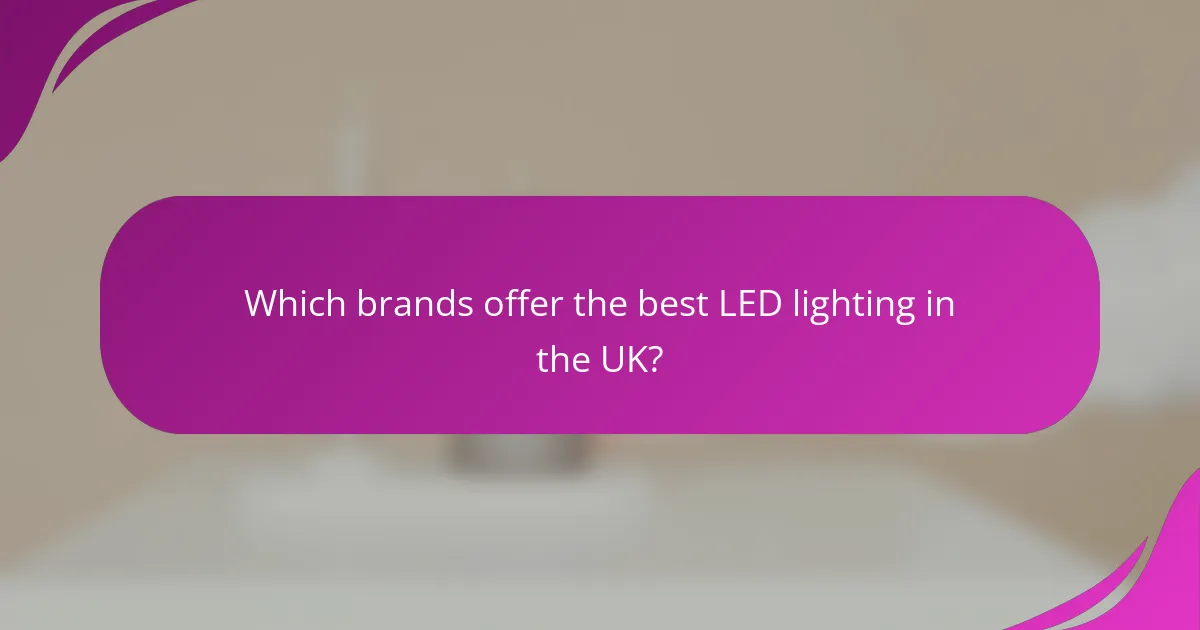
Which brands offer the best LED lighting in the UK?
In the UK, Philips, Osram, and GE are among the top brands known for their high-quality LED lighting solutions. Each brand offers a variety of products that cater to different needs, from energy efficiency to design aesthetics.
Philips LED lighting
Philips is renowned for its innovative LED lighting technologies that provide excellent energy efficiency and longevity. Their products often feature smart lighting options, allowing users to control brightness and color through mobile applications.
When considering Philips LED lights, look for their Energy Star ratings, which indicate superior energy performance. Prices typically range from £5 to £50, depending on the type and features of the bulb.
Osram LED lighting
Osram offers a wide selection of LED lighting products that focus on both residential and commercial applications. Their lights are designed to provide high-quality illumination while minimizing energy consumption.
Osram’s products often come with a warranty, providing peace of mind regarding durability. Expect to pay between £4 and £45 for their LED bulbs, depending on specifications and technology used.
GE Lighting products
GE Lighting is known for its reliable LED solutions that combine performance with affordability. Their range includes everything from standard bulbs to specialty lighting designed for specific applications.
GE products are generally priced between £3 and £40, making them accessible for various budgets. Look for features like dimmability and color temperature options to suit your lighting needs.
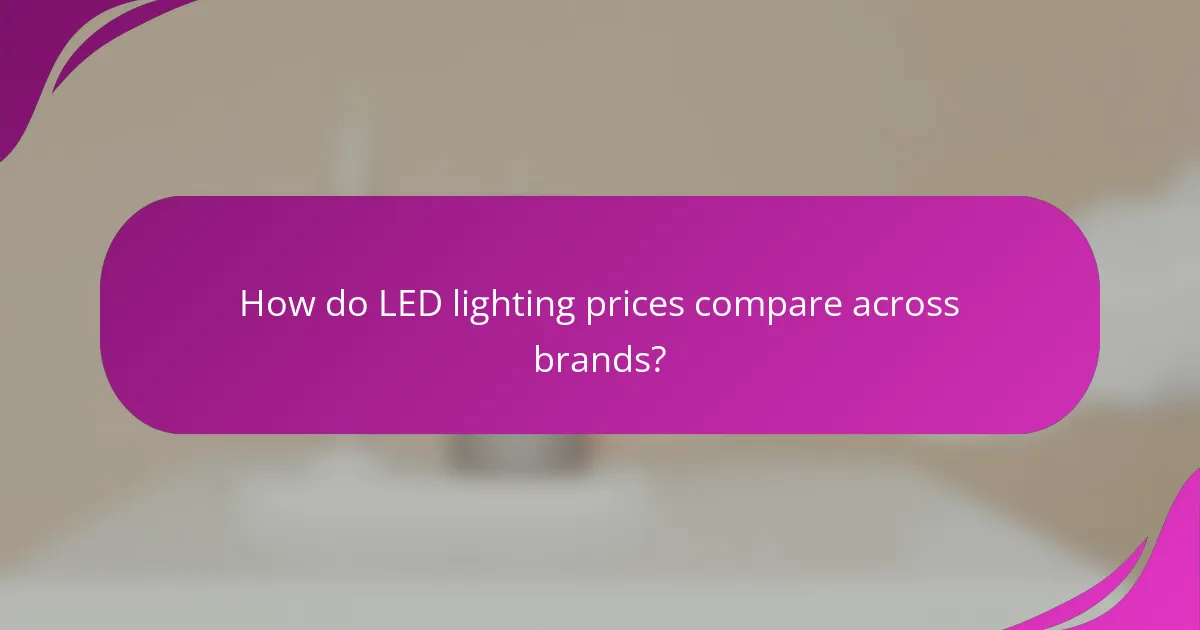
How do LED lighting prices compare across brands?
LED lighting prices vary significantly across brands, influenced by factors such as technology, quality, and features. Generally, well-known brands like Philips and Osram tend to be priced higher due to their reputation for reliability and performance.
Philips vs. Osram pricing
Philips and Osram are two leading brands in the LED lighting market, each offering a range of products at different price points. Philips typically prices its LED bulbs between £5 to £15, while Osram’s offerings can range from £4 to £12. The price difference often reflects the specific features and energy efficiency ratings of the products.
When comparing these brands, consider the warranty and lifespan of the bulbs. Philips often provides longer warranties, which can justify the higher price for consumers looking for longevity and reliability.
GE vs. Philips pricing
GE’s LED lighting products are generally positioned competitively against Philips, with prices ranging from £3 to £10 for standard bulbs. Philips, however, may offer more premium options that can exceed £15, particularly for smart lighting solutions. This pricing strategy reflects Philips’ focus on innovation and advanced features.
For consumers, the choice between GE and Philips may come down to specific needs, such as smart home compatibility or design preferences. GE often provides solid performance at a lower price, making it a good option for budget-conscious buyers.

What are the benefits of using LED lighting?
LED lighting offers numerous advantages, including significant energy savings, long lifespan, and reduced environmental impact. These benefits make LEDs a popular choice for both residential and commercial applications in the UK market.
Energy efficiency
LED lights are known for their exceptional energy efficiency, consuming up to 80% less electricity than traditional incandescent bulbs. This efficiency translates into lower energy bills, making them a cost-effective option over time.
When selecting LED lighting, consider the lumens per watt (lm/W) rating. High-quality LEDs typically offer around 80 to 100 lm/W, ensuring you get maximum brightness for minimal energy use. This efficiency is particularly beneficial in the UK, where energy costs can be high.
Longevity and durability
LED lights have a lifespan of approximately 15,000 to 50,000 hours, far exceeding that of traditional bulbs. This longevity means fewer replacements, reducing waste and maintenance costs.
Additionally, LEDs are more durable due to their solid-state construction, making them resistant to shocks and vibrations. This durability is ideal for various settings, including homes, offices, and outdoor areas, where traditional bulbs may fail more quickly.
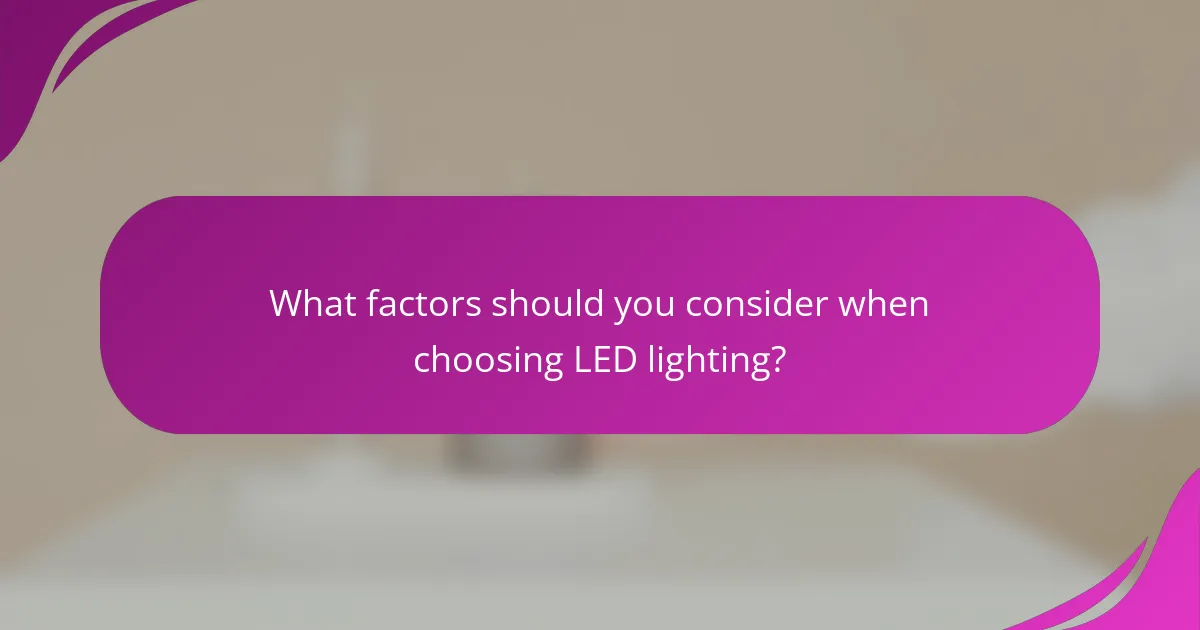
What factors should you consider when choosing LED lighting?
When selecting LED lighting, consider brightness, color temperature, energy efficiency, and brand reputation. These factors will influence the suitability of the lighting for your specific needs and environment.
Brightness levels
Brightness in LED lighting is measured in lumens. For general home lighting, aim for around 800 lumens for a standard bulb, while task lighting may require 1,200 lumens or more. Higher lumen counts provide brighter light, which is essential for spaces like kitchens or work areas.
Keep in mind that the perceived brightness can vary based on the color temperature and the design of the fixture. It’s advisable to test different brightness levels in your space to find what feels comfortable and functional.
Color temperature options
Color temperature is measured in Kelvin (K) and affects the ambiance of a space. Common options range from warm white (around 2700K) to cool white (up to 6500K). Warm white is ideal for living areas, while cool white is often preferred for workspaces.
When choosing color temperature, consider the purpose of the room and the mood you want to create. Warmer tones can make a space feel cozy, while cooler tones can enhance focus and alertness. Testing different temperatures in your environment can help you make the best choice.
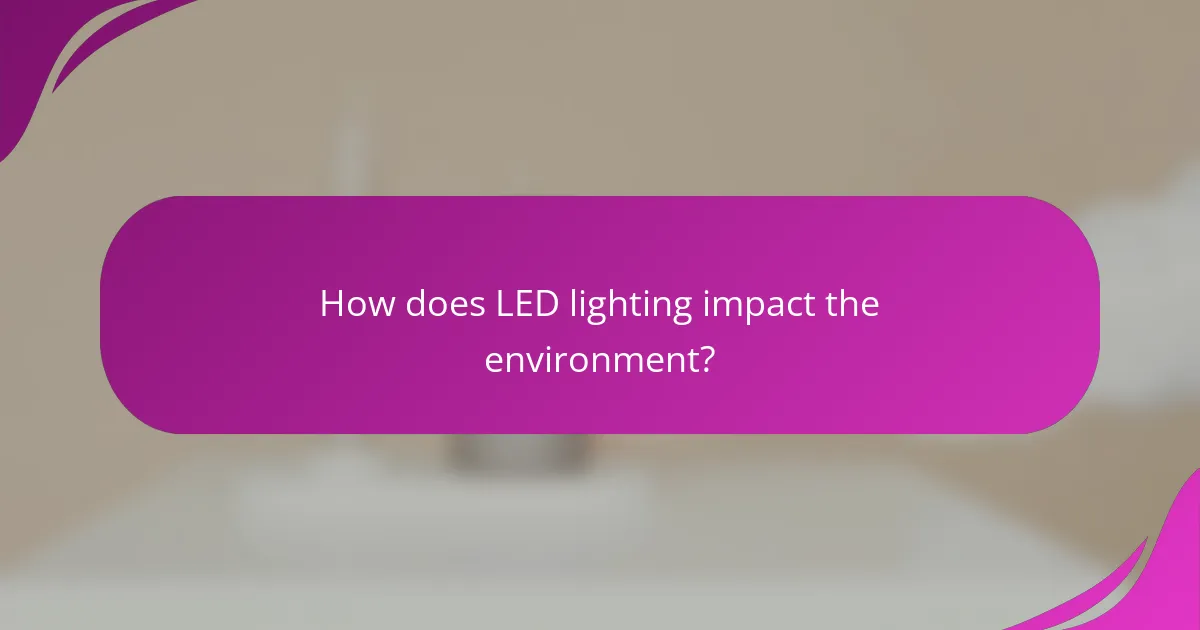
How does LED lighting impact the environment?
LED lighting significantly reduces environmental impact through lower energy consumption and longer lifespans compared to traditional lighting. This results in decreased greenhouse gas emissions and less waste generated over time.
Reduced carbon footprint
LED lights consume considerably less electricity than incandescent or fluorescent bulbs, leading to a reduced carbon footprint. By using around 75% less energy, they contribute to lower power plant emissions, which is crucial for combating climate change.
For example, switching to LED lighting in a typical household can save several hundred kilograms of CO2 emissions annually. This not only benefits the environment but can also lead to substantial savings on energy bills over time.
Less hazardous waste
LED lighting generates less hazardous waste compared to traditional bulbs, particularly fluorescent lights that contain mercury. Since LEDs have a longer lifespan, they need to be replaced less frequently, further reducing waste.
In the UK, proper disposal of hazardous waste is regulated, and using LEDs helps minimize the burden on waste management systems. Households and businesses can contribute to a more sustainable future by opting for LED lighting solutions.

What are the latest trends in LED lighting technology?
The latest trends in LED lighting technology focus on enhanced energy efficiency, smart integration, and human-centric designs that improve well-being. Innovations are driving down costs while increasing functionality, making LED lighting more accessible and versatile for various applications.
Smart LED lighting integration
Smart LED lighting integration allows users to control their lighting through apps or voice commands, enhancing convenience and energy management. Systems can be programmed to adjust brightness and color temperature based on time of day or occupancy, leading to energy savings and improved comfort.
Popular platforms include Philips Hue and LIFX, which offer a range of smart bulbs compatible with home automation systems. When choosing smart LEDs, consider compatibility with existing devices, ease of installation, and whether the system supports features like scheduling and remote access.
Human-centric lighting solutions
Human-centric lighting solutions focus on aligning artificial light with natural circadian rhythms to promote health and well-being. These systems adjust color temperature and intensity throughout the day, mimicking natural daylight patterns to enhance mood and productivity.
For example, warmer tones in the morning can help energize users, while cooler tones in the evening can prepare them for rest. When implementing human-centric lighting, consider the specific needs of the space, such as residential versus commercial environments, and the potential impact on occupants’ comfort and performance.


